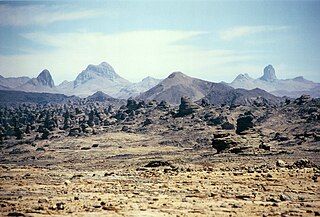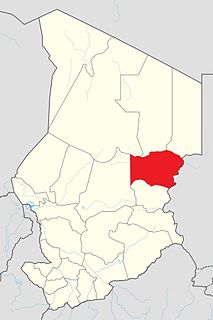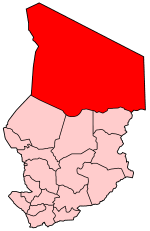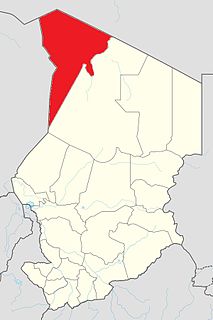
Chad, officially known as the Republic of Chad, is a landlocked country in north-central Africa. It is bordered by Libya to the north, Sudan to the east, the Central African Republic to the south, Cameroon to the south-west, Nigeria to the southwest, and Niger to the west.

The Tibesti Mountains are a mountain range in the central Sahara, primarily located in the extreme north of Chad, with a small portion located in southern Libya. The highest peak in the range, Emi Koussi, lies to the south at a height of 3,415 meters (11,204 ft) and is the highest point in both Chad and the Sahara. Bikku Bitti, the highest peak in Libya, is located in the north of the range. The central third of the Tibesti is of volcanic origin and consists of five volcanoes topped by large craters: Emi Koussi, Tarso Toon, Tarso Voon, Tarso Yega and Toussidé. Major lava flows have formed vast plateaus that overlie Paleozoic sandstone. The volcanic activity was the result of a continental hotspot that arose during the Oligocene and continued in some places until the Holocene, creating fumaroles, hot springs, mud pools and deposits of natron and sulfur. Erosion has shaped volcanic spires and carved an extensive network of canyons through which run rivers subject to highly irregular flows that are rapidly lost to the desert sands.
The Republic of Chad is made up of twenty-three regions.

Wadi Fira is one of the 23 regions of Chad. Its capital is the town of Biltine. The region corresponds with the former prefecture of Biltine.

The regions of Chad are divided into 61 departments. The departments are listed below, by name and by region.

The Borkou-Ennedi-Tibesti (BET) was until 2008 one of the then 18 regions of Chad, its capital being Faya-Largeau. It comprised the former Borkou-Ennedi-Tibesti Prefecture. Most of the region was part of the Sahara desert.

The administrative divisions of Chad have often changed since 1900, when the territory was first created by France as part of its colonial empire, with the name Territoire Militaire des pays et protectorats du Tchad. The first subdivision took place in 1910, when 9 circumscriptions were made, named départements (departments) in 1935 and régions (regions) in 1947. As for the regions, they were further divided in districts.
Borkou is one of two departments of the Borkou Region in Chad. It was established by Ordinance No. 002/PR/08 of 19 February 2008. Its capital is Faya-Largeau.
The National and Nomadic Guard of Chad is one of five defence and security forces in Chad. Article 200 of the Constitution of 1996 states that the duties of the GNNT are the protection of politicians and government officials, guarding government buildings, the maintenance of order in rural areas, and guarding prisons and prisoners.These responsibilities remain unchanged in the new Constitution of 2018 but are now in Article 195.
Oueddei Kichidemi was the father of the former Chadian President Goukouni Oueddei and was the tribal leader, or derde, of the Toubou Teda of the Tibesti during the First Chadian Civil War.

Zouar is a town in the Tibesti Ouest department of the Tibesti region in northern Chad, located in an oasis in the Tibesti Mountains. Prior to 2008 it was in the Tibesti Department of the former Bourkou-Ennedi-Tibesti region

The departments of Chad are divided into 348 sub-prefectures (sous-préfectures).
The Télé Tchad is the national broadcaster of the Central African state of Chad. Télé Tchad currently broadcasts in Arabic and French. It primarily broadcasts news, educational programming, cultural and religious programming, and local sport.

The Borkou region is a region of Chad which was created in 2008 from the Borkou department of the former Borkou-Ennedi-Tibesti region. Its capital is Faya-Largeau.

Tibesti Region is a region of Chad, located in far northwest of the country. Its capital is Bardaï. It was created in 2008 when the former Borkou-Ennedi-Tibesti Region was split into three, with the Tibesti Department becoming the Tibesti Region. The region is named for the Tibesti Mountains, one of the most prominent mountain chains in the Sahara Desert.

Ennedi-Ouest Region is one of the twenty-three region of Chad.
Borkou Yala is a department of Borkou Region in Chad. It was created by Order No. 002 / PR / 08 of 19 February 2008. Its chief town is Kirdimi.

The Military Command Council for the Salvation of the Republic is a Chadian militant rebel group that seeks to overthrow Idriss Déby, President and de facto dictator of Chad. Founded in 2016, it currently operates in the border regions of northern Chad, southern Libya, eastern Niger, and western Sudan. The CCMSR has become involved in the Second Libyan Civil War, and took control of the Kouri Bougoudi area in northern Chad in 2018.
Chad National Concord/Convention was a Chadian rebel group active during the Third Chadian civil war. It was founded in 2004 by Hassan Saleh Al-Gaddam ‘Al-Jineidi’. Al-Gaddam was a vice-president of FUC, but in July 2006 he broke away from FUC and lead CNT into a separate rebellion against Chadian government. The CNT captured the areas of Daguessa and Tissi and managed to hold control of them for few months in 2006 and 2007. The CNT had close ties with Janjaweed. Leader of CNT, Al-Gaddam participated in Sirte talks and agreed to a ceasefire with Chadian government in October 2007. CNT rallied to Chadian government shortly after failure of Sirte agreement in December 2007. When the group rallied to the government it had 2000 members.










